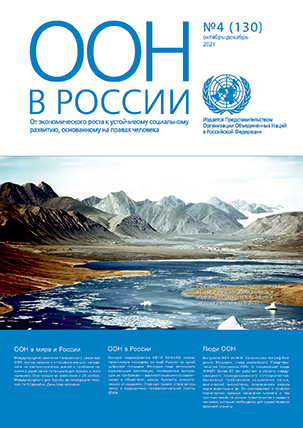Art Against AIDS
The international exhibit Art Against AIDS opens January 13 in Moscow at the Central House of Artists (Krymskii Val 10). The exhibit was conceived upon the initiative of the Joint UN Programme on HIV/AIDS (UNAIDS). Thirty- eight-artists from Russia, the United States, Ukraine, Spain, and Greece are represented, and a cycle of 25 photographs from Stars Against AIDS by Serge Golovach is featured.
Exhibit participants feel that society must become aware of HIV/AIDS issues and strive to do so through their art. The project, which has united famous and young painters and graphic artists, aims to reduce discrimination against people living with AIDS and increase tolerance. Participants include Anna Birstein, Pavel Kaplevich, Maria Maikova, Lyudmila Voronova, Aleksander Tsygankov, Andrey A.Sarabyanov, Aleksander Yastrebenetzky, Georgy Frangulyan, Sarah Watterson (US), Martina Anagnostu (Greece), Genoveva Fernandes (Spain), and others. A significant portion of the exposition is dedicated to panoramic photographs of Russian and Ukrainian stars taken by photographer Serge Golovach as part of the UNAIDS project Stars Against AIDS. Well-known figures from art, culture, and sports—such as ballerina Svetlana Zakharova; singer Diana Gurtzkaya; actresses Marina Aleksandrova, Dina Korzun, Alika Smekhova, and Alena Khmelnitzkaya; and Olympic champions Svetlana Khorkina, Maria Kiseleva and other—took part in the project.
Dina Korzun said, “I knew practically nothing about the scale of the HIV/AIDS epidemic in our country before this project because I don’t see it in everyday life. My personal experience clearly shows that the greatest problem is not knowing and, as a result, the lack of social tolerance. I know of a concrete example. A girl who was diagnosed with HIV needed to have a tooth pulled. She, of course, told the doctor, but he kicked her out of his office and refused to work on her. So the girl was faced with a dilemma: either hide her status or accept it and risk being an outcast. This is obviously an unacceptable reaction in a civilized society, especially since many people get HIV by pure accident. I have a 17-year-old son and know how important it is for him to understand the issue. Society has to get used to hearing about it, and there has to be more diverse and numerous projects like Stars Against AIDS and Artists Against AIDS. The task of art—our task—is to excite emotions, force the viewer to think about issues, and experience them.”
Today, there are approximately 440 000 officially registered cases of HIV infection in Russia; however, many Russian and international experts estimate the actual number of people living with HIV to be about one million. Injecting drug users constitute the primary risk group, but the epidemic continues to spread and has begun affecting the primary population. Over the past few years, the share of women living with HIV has grown. In 2007, 44% of new HIV infections were registered in women. In addition, the number of children born to women living with HIV has increased and now totals about 3000.
“The exhibit Art Against AIDS is an integral part of the UNAIDS effort to combat HIV/AIDS that seeks to change public sentiment regarding HIV and foster tolerance towards people living with HIV. Partnerships with well-known figures from art, cinema, and sports are aimed at bolstering social responsibility and altering public mentality. By working together, we strive to increase HIV awareness in order to promote social health, make known the hazards of HIV infection, and stop the spread of the epidemic. It is critically important that artists be our allies in combating the epidemic. Art plays a significant role in influencing the mind and mentality of society. We are attempting to establish a new fashion: be healthy, think not only about your own health but also about the health of your partner, and maintain tolerant relationships with those who need help and support. We are happy that the first exhibit evoked so much interest amongst painters that many sought to join the project and make their own contribution to combat HIV/AIDS”, - says Marina Semenchenko, Coordinator for Russia, a.i.
Today, there are approximately 440 000 officially registered cases of HIV infection in Russia; however, many Russian and international experts estimate the actual number of people living with HIV to be about one million. Injecting drug users constitute the primary risk group, but the epidemic continues to spread and has begun affecting the primary population. Over the past few years, the share of women living with HIV has grown. In 2007, 44% of new HIV infections were registered in women. In addition, the number of children born to women living with HIV has increased and now totals about 3000.
The exhibit is an extension of work under the Joint UN Programme on HIV/AIDS in Russia to bring HIV/AIDS awareness to diverse social strata and increase tolerance towards people living with HIV. In 2008, the exhibit Stars Against AIDS was organized and shown in Rostov-na-Donu and Moscow. A total of 15 000 USD was raised during the benefit exhibit and sale Artists Against AIDS, and the proceeds went towards the Lomonosov Orphanage for HIV-infected children in Leningrad Oblast.
The exhibit is open in the Central House of Artists from 13–19 January 2008.
For more information, contact Anna Chernyakhovskaya,
UNAIDS Advocacy and Communications Advisor
chernyakhovskaya@unaids.org
Telephone + 7 495 663 6797, 8 916 248 9512

